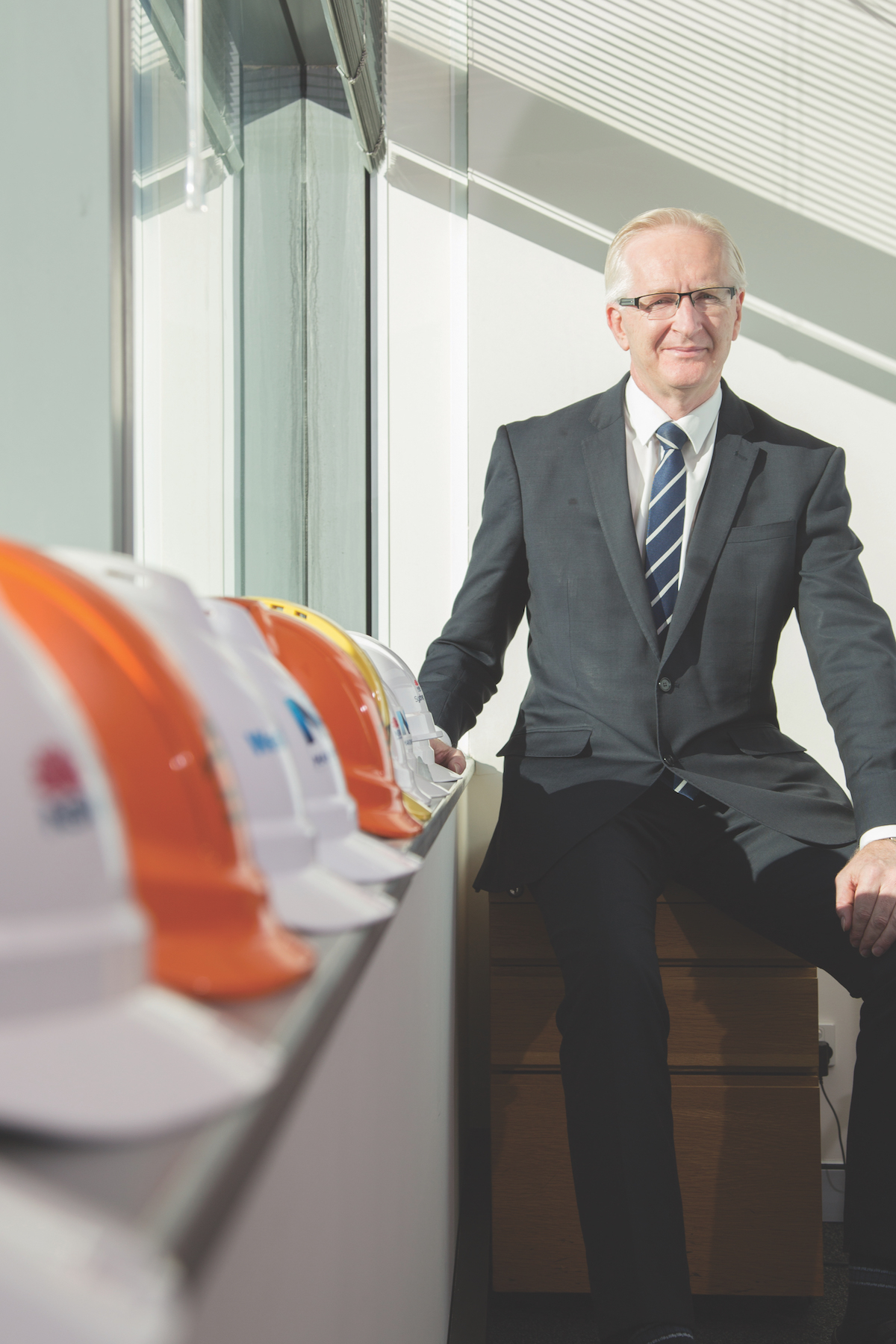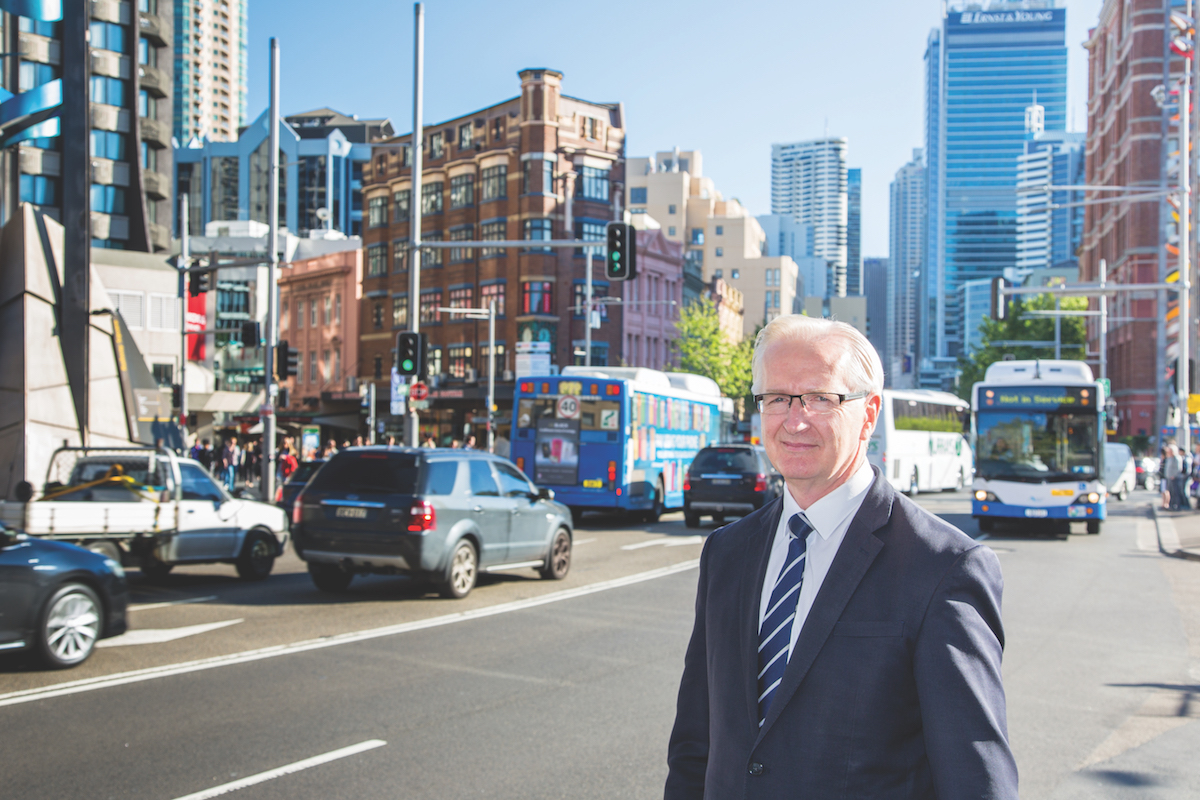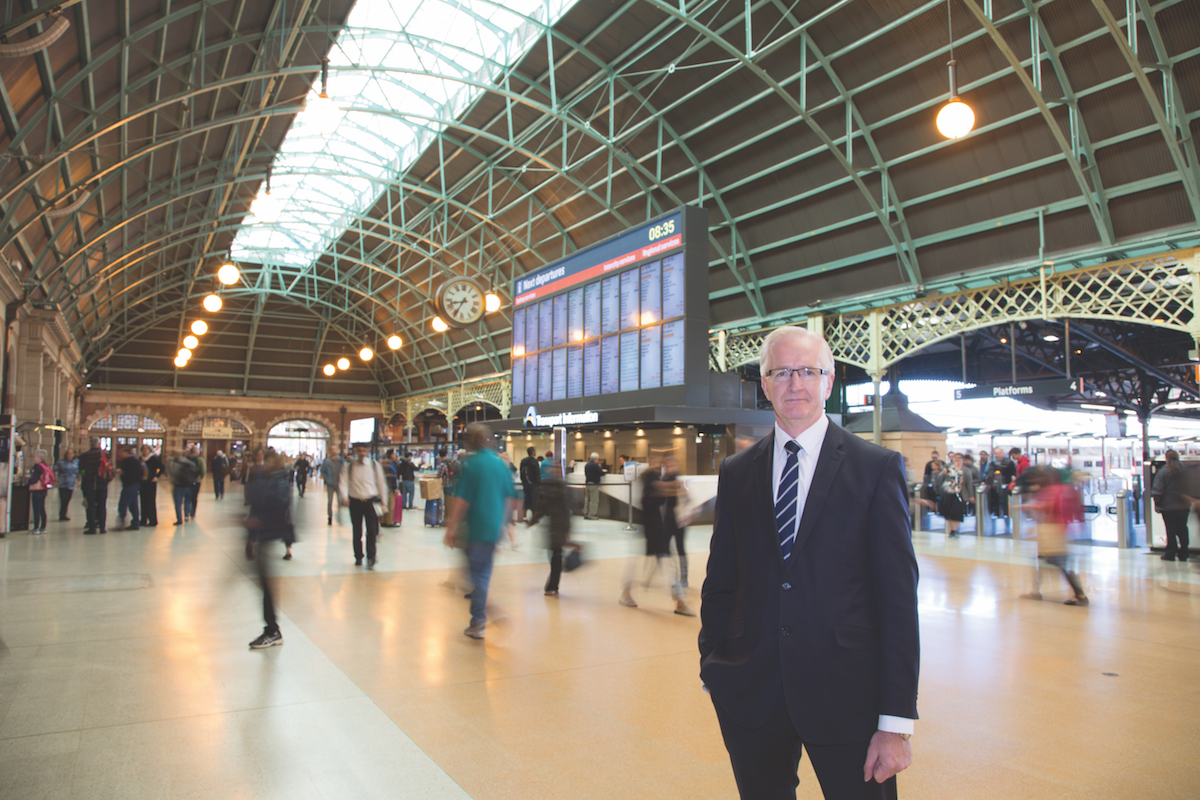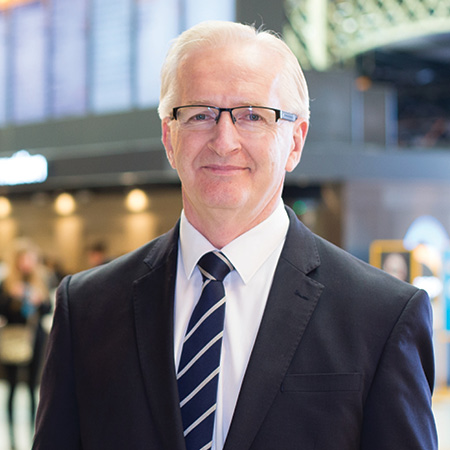As Secretary of Transport for NSW, Tim Reardon is making it his mission to think differently about how to meet the state’s transport needs now and into the future. His aim: to provide efficient, and in some areas, world-class transport services as the state’s population grows from 7.5 million to 9.5 million by the 2030s. Getting there means harnessing technology, developing supplier partnerships nationally and internationally, and drawing into the organisation people with very different skill sets.
It’s trip-planning on steroids, but he’s relishing the task. “Doing things traditionally, we plan, design and deliver new motorways; we plan, design and deliver a new railway line; and that would traditionally be the start and the end of it,” he says.
“With all of the technologies that are available now, we can leverage upstream to provide potentially faster ways to design and plan how we go about delivering that new motorway or that new rail line. So that is a very big opportunity — plus, it provides a whole range of new jobs that probably haven’t been invented yet.”
More data ‘than most customer bases of any organisation in Australia’
Then there are the opportunities offered by data. “As a Transport cluster with more than eight million Opal Cards that are in circulation now and almost six million driver licences, to name just two data sources, plus the millions of trips that are taken every day, we have more data than most customer bases of any organisation in Australia.”
It’s an abundance of data that could completely change and disrupt the way the organisation does its strategic planning, transport planning and transport modelling. “We provide that data and put it out into the community so innovators, entrepreneurs, intrapreneurs, universities and anyone else who is interested can come and pitch ideas back to us.”

“I think we are at the tip of the iceberg. The sky is the limit for where we could take the opportunities to personalise people’s travel.” – Tim Reardon
Gone are the days of long-term plans that are implemented for 20 years and are out of date in five. “We need far more nimble scenario-based planning, and far more direct connection with our community, asking them how they would like to see transport services in their area evolve.”
Tim believes communities not only want more direct say in how transport services are provided and evolve, they also want to be “much more engaged in a digital way than they ever have before”.
Apps that help people get to where they’re going
The organisation has already delivered a variety of apps for customers: those that help them to understand public transport services in real time; those that help them plan their trips to sidestep traffic congestion; and those that provide accessibility to people with a disability. With take-up rates of some of those products in the millions, Tim describes it as “wonderfully successful”. But he’s not stopping there. “I think we are at the tip of the iceberg. The sky is the limit for where we could take the opportunities to personalise people’s travel.”
At the heart of those developments is an opportunity to empower customers to work with the transport system and use other options such as autonomous vehicles and ride-sharing. “Instead of us just putting up a paper timetable at a bus stop, we want to empower customers so they can make the right choices for themselves.”
It comes as no surprise that he nominates a passion for serving his community as a guiding principle in his professional life. The passion has its roots in his country upbringing. He grew up in the regional New South Wales town of Condobolin. “You grow up a country kid and it gives you a robust and simplified view of life,” he says.

Trained in transport, passionate about community service
Keeping things simple has stood him in good stead in a career that has been almost exclusively devoted to transport. He cut his teeth doing project work on road design and traffic engineering at the Roads and Traffic Authority, before taking his professional life overseas, working in London and Dublin on motorway design and bus priority implementation. The bus priority implementation project in London involved a detour into the private sector. But when he returned to New South Wales in the late 90s, it was to a public sector preparing for the Sydney Olympics. “I worked with transport leading into the Olympics and played a role there in operations management out at the athlete village during the Olympics, which was great fun.”
He describes it as a “very instructive time”, giving the transport sector a vision for how transport should run: simply and effectively. “It was effective because we could make millions of customers very happy.”
Ignited by that vision, Tim set his sights on a director-general or secretary role in the future. “I thought running Transport and leading it would be an honour and a privilege.”
With that aspiration in mind, he spent several years working at the Queensland Government’s Department of Premier and Cabinet to experience a different frame of reference, as well as several more years in the private sector.
Fast track to achieving goals
When he returned to his first love, transport, in 2011 as the Deputy Secretary, Freight, Strategy and Planning at Transport for NSW, he had a clear vision of what he wanted to achieve. “I had seen New South Wales flourish in some ways in the 90s and then have a very difficult decade from 2000 to 2010 when we weren’t building projects. We weren’t expanding the transport network; we were somewhat stop–start in terms of transport plans, and there was a great deal of uncertainty and lack of clarity within the public service.”
His goal: to take the sector’s “tarnished” reputation and turn it around as fast as possible.

With the New South Wales population set to expand from 7.5 million to 9.5 million in the next 20 years, his aim was to deliver transport services that are on a par with some of the best in the world. “I was pretty determined to ensure that, when people think about New South Wales, they think about it as somewhere they can come and live, work and visit, and actually enjoy a really good quality of transport — and in certain areas, world-class transport services that they can be proud of: new trains, buses, ferries, light rail, delivering motorways when we said we would, and getting on with it.”
It’s not an easy ambition to realise, says Tim. “We worked really hard the first year, just trying to get the basics right.”
Out went some old agencies such as RailCorp, the Roads and Traffic Authority, and the old Ministry of Transport. In came Sydney Trains, Transport for NSW, and Roads and Maritime Services.
Then it was on with the task of delivering the day-to-day transport services used by millions of people across New South Wales, as well as planning and delivering the new infrastructure the state’s transport systems would need to accommodate the expected population growth by 2030.Tim is also looking ahead to what will be needed beyond that in the decade from 2020 to 2030.
The next decade: Transport for NSW from 2020 to 2030
He feels fortunate to be tackling the task at a time when there is the political will, resources and funding to implement it. “When you get those things coming together at the same time, best you move fast — and we are trying to move as fast we can.”
Bringing his vision for transport services to life means positioning the organisation so that it attracts the people and partnerships it needs to make it happen. It has a $41.5-billion capital works program over the next 4 years on top of its annual recurrent service delivery and expenditure. “As Transport for NSW and the Transport cluster in this state, we would probably have more partners and suppliers than most other parts of the economy in Australia.”

“As Transport for NSW and the Transport cluster in this state, we would probably have more partners and suppliers than most other parts of the economy in Australia.” – Tim Reardon
To find ‘best of breed’ suppliers, construction groups, professional services groups, contractors, consultants and legal support, it is not just a case of looking locally and nationally, but internationally as well. “In the next few years,” Tim explains, “we will have people providing services or delivering pieces of infrastructure or rolling stock from various places in New South Wales and Australia, as well as in Europe and Asia.” Then there are technology partners. “If we are putting a new app out, for example, and we run a hackathon on a Saturday morning that produces a product on a Sunday night, we may find we have 30 new partners just in that weekend. We will work through a short list of those groups to see if they can produce a product that our customers want.”
That focus on the customer is also driving cultural change within the entire Transport cluster in New South Wales. It’s a change that started in 2011 when Transport for NSW was established as an integrated transport agency that set policy, strategy and planning for the entire transport system. The Transport cluster in New South Wales includes State Transit, Sydney Trains, NSW Trains, and Roads and Maritime Services.
“That is something that I think the community was probably crying out for over a long time, so they knew who to speak to and how to communicate about what their transport needs were,” Tim comments.
Last year, Tim and each of the chief executives of the 4 agencies signed a Transport cluster charter. “That told the entire 25,000 people across the cluster how we would work together; how we maintain a one-cluster approach; and how we see the transportation system as a service that delivers for customers. We don’t just see the world as a road, a railway line, or a ferry, and we don’t see the modes of transport as competing with each other; we see it as a one-customer, and therefore a one-cluster, approach to respond to what customers want.”
Women and Indigenous Australians to play a critical role in organisational culture
Looking ahead, Tim sees that women and Indigenous Australians will play an important role in the organisation’s cultural change. “We need different skill sets going forward for the new opportunities and challenges, and therefore there is a whole range of different people we need working with us.”
Currently, women account for 1 in 5 of the people in leadership roles. Tim wants to lift that to 1 in 2 in the medium term. It’s a priority he is monitoring directly. “I am very passionate about achieving an organisation that reflects the community it serves as soon as practicable, and that requires a lot of drive and determination.”
Underpinning the commitment to gender balance are policies that support flexibility. There are programs to maintain connections for people who are returning to work from parenting roles, and others that support activity-based contemporary workplaces.
“We have the opportunity to do that because we have so many new project delivery offices.”
Upping its female appeal also means adjusting traditional recruitment practices such as merit-based selection. “That sometimes leads to more men being put in place by more men who recruit more men. So we are doing all we can to flip that on its head. We are achieving some results, but we have got a long way to go.”
Indigenous representation is another area of focus, and not just because of the NSW Government’s target to double the number of Aboriginal and Torres Strait Islander people in senior leadership positions within 10 years.
“I will do all I can, not because I set a target but because it is the right thing to do,” he says, adding the organisation is currently providing specific training and skills development for Aboriginal staff within its major projects. His aim: to provide long-term Indigenous employment and long-term Indigenous leaders within the Transport cluster so that it is known as an Indigenous-friendly place to work.
“The entire executive team of Transport for NSW and the entire executive team of all of the agencies that work within the Transport cluster across trains, roads, buses and light rail, are all joined at the hip when it comes to women in leadership, flexibility, and Aboriginal representation,” Tim says.
He admits the cultural transformation of the Transport cluster is a “voyage of evolution”.
“It is an ongoing journey of ensuring we are aligned, ensuring that collaboration is key, and ensuring that collaboration actually delivers greater and more efficient outcomes on behalf of customers — which is why we all get up in the morning and come to work.”



